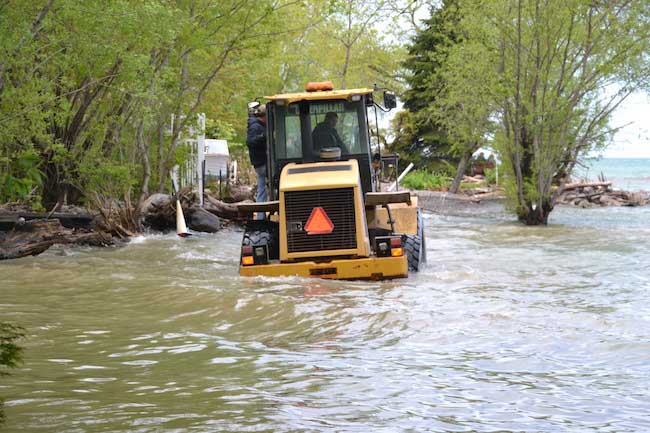Governor demands immediate action from IJC with Lake Ontario flooding

Photo by Tom Rivers: The Carlton Highway Department uses a payloader to cross a washed out road from the high Lake Ontario waters. This photo is from June 1 when the town moved pallets of sandbags to helped three houses that no longer could reach their homes by car.
Press Release, Gov. Andrew Cuomo
Governor Andrew M. Cuomo today issued a letter to the International Joint Commission demanding immediate action in response to Lake Ontario flooding.
The full text of the letter is available below:
Dear Chairpersons Corwin and Phare:
For the second time in three years, many communities and businesses along the Lake Ontario Shoreline are experiencing flooding because of record-high water levels. As a result, New York State has responded, committing over $100 million in funds to repair shoreline properties in 2017, and spending tens of millions more to respond to flooding this year. The International Joint Commission (IJC) has no excuse for its failure to prepare for adequately managing the high-water levels Lake Ontario has experienced and continues to experience this year. The IJC was put on notice in 2017 when the Lake set high-water level records and should have been aware of the present danger from the massive snowpack and likelihood of continued rains into the spring of this year. Yet, rather than acting, the IJC continued the status quo, resulting in more flooding and more property damage in New York. We demand that the IJC make New York whole for its millions in unreimbursed expenditures, and that the IJC modify its water management and planning to reduce the flooding and damage being done to New York’s shoreline communities.
The current devastation and the ongoing threat to the citizens and businesses of New York caused by Lake Ontario flooding must be remedied. Senator Ortt has raised the possibility of legal action, which he suggested in a letter to the state Attorney General. With water levels in Lake Ontario now exceeding the historic high levels of 2017, immediate action must be taken to deter flooding in the Lake Ontario-St. Lawrence River system.
In 1909, the United States and Great Britain, acting on behalf of Canada, entered into the Boundary Water Treaty to enable both nations, and their respective citizens and component jurisdictions, to make beneficial use of boundary waters consistent with the rights and interests of all public and private riparian owners. The Treaty expressly provides that domestic and sanitary uses are to be given preference over navigation and power uses. The Treaty also provides that construction of any dam or obstruction requires the protection and indemnity against injury of all interest on either side of the Boundary.
Throughout its history, the IJC has struggled to balance the competing needs of all beneficiaries. In the early 1950s, for example, the IJC’s management of Lake Ontario caused substantial flooding damage to New York residents, who responded with strong protests and litigation. In part as a result, the IJC removed the Gut Dam and lowered maximum water levels by some three feet. The IJC also issued a new Supplementary Order of Approval in 1956, which remained in effect for more than five decades.
In 1999 the IJC undertook a study to assess water levels under the application of the 1956 Order. This study resulted in the adoption of Plan 2014. In adopting the plan, the IJC found that the 1956 Order did not “accurately reflect the full range of experienced conditions or anticipate future changes” and that it was necessary to now “consider environmental issues and recreational boating.” Plan 2014 also provided that discharges of water would be administered “in such a manner as to provide no less protection for navigation and riparian interests downstream than would have occurred under pre-project conditions.” Moreover, as part of the criteria for administering discharges, the IJC found that “the levels of Lake Ontario shall be regulated for the benefit of property owners on the shores of Lake Ontario in the United States and Canada so as to reduce extremes of stage which have occurred under pre-project conditions and supplies of the past as adjusted on Lake Ontario.”
In adopting Plan 2014 the IJC found that the new regulatory scheme would result in “less frequent deviations from a regulation plan” and would “provide long-term benefits, upstream and downstream … with greater security and predictability.” The high-water events of 2017 and 2019 demonstrate that this could not be farther from the truth. The IJC must provide a more protective management system that delivers on the promises that it made in adopting Plan 2014.
Flooding and other high-water impacts continue around the Great Lakes, including Lake Ontario and the upper St. Lawrence River, especially during periods of active weather, such as that observed recently. On June 4, 2019, Lake Ontario remained at 75.90 m (249.02 ft), extending the new historic lake level record first reached on June 2, 2019. It is expected that the water level of Lake Ontario will continue rising gradually over the next several days. Lake Erie water levels and outflows into Lake Ontario remain above record-highs and have risen slightly over the past several days.
While floods and high-water levels damage New Yorkers’ property, water levels in Montreal Harbor are below record-highs for this time of year and continue to drop. To provide relief to New York’s adversely affected riparian owners, the IJC must immediately maximize the outflows to the greatest extent possible, even if that impacts navigation along the river temporarily.
The IJC has acknowledged that its actions, or lack thereof, have served to protect commercial shipping at the expense of riparian land-owners. But, under its own foundational treaty and under Plan 2014, it cannot refrain from such releases to protect commercial shipping interests over the safety and property of New Yorkers. The Boundary Waters Treaty of 1909 states that “no use shall be permitted which tends materially to conflict with or restrain any other use”. Moreover Plan 2014 specifically states that “[i]n the event that Lake Ontario water levels reach or exceed extremely high levels, the works in the International Rapids Section shall be operated to provide all possible relief to the riparian owners upstream and downstream.” The burden of high-water flows must be shared equally among all users of the system – including the transportation and shipping sector.
In 2017, New York took action to protect communities from further flooding and delivered critical State and federal funding to help families and businesses rebuild. The State committed over $100 million to rebuild communities along the Lake Ontario shoreline that were devastated by the flooding in 2017, only to once again this year experience record high-water levels and flooding in those same communities. Following the 2017 flooding, the IJC knew or should have known of the significant potential for future flooding events, but failed to exercise the forethought to protect against the devastating impacts of flooding.
New York continues to address the impacts from past flood levels and mitigate potential future flooding. New York is staging equipment and sand bags; working closely with municipal governments along the shorelines; advancing and reimbursing flood protection and remediation projects; and providing support for resiliency planning efforts. New York expects that the cost associated with rebuilding and providing future resiliency will exceed costs from 2017 and be well over $100 million. New York also strongly urges the appropriation of federal funding, which is critical for continuation of those efforts and additional efforts to improve coastal resiliency along the Lake and River. New York should not have to bear the costs solely for the impacts of this international plan and federal funding is critical to addressing the consequences.
The IJC’s power to act derives from the Boundary Waters Treaty, which prioritizes non-power uses of Lake Ontario and the St. Lawrence River. It is apparent that the IJC’s management has not adequately addressed the new normal of extreme high-water events that have disproportionately affected the riparian owners in New York. The IJC must ensure that it considers and addresses these extreme wet weather conditions that have led to extensive flooding in two of the last three years in future planning and implementation of flows moving forward. The IJC must adopt a fairer course to ensure that the protection of the public on both sides of the Lake and the River are, at all times, its highest priority.
In light of the devastating flooding occurring, the State of New York demands that the IJC reimburse New York for its costs, and make additional funds available for resiliency projects and other protective measures made necessary by the IJC’s acts and omissions. The IJC must also immediately determine how much water can be safely released, irrespective of shipping, and release that amount. Finally, the IJC must immediately correct its water management protocols to avoid damage to riparian owners. Failure to act upon these demands will result in New York taking any and all actions to compel the IJC to act, including legal action.
Sincerely,
Governor Andrew M. Cuomo





































































